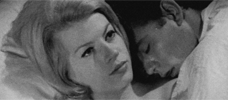Reviews
Reviews Bosomania!: The Sex, the Violence, and the Vocabulary of Russ Meyer

Beyond the Valley of the Dolls
Russ Meyer
USA, 1970
Credits
Review by Megan Weireter
Posted on 06 September 2008
Source 20th Century Fox DVD
Related articles
Reviews Beyond the Valley of the Dolls by Rumsey
Categories Bosomania!: The Sex, the Violence, and the Vocabulary of Russ Meyer
If you’ve only seen one Russ Meyer film, chances are it’s Beyond the Valley of the Dolls, and that’s not a bad thing: in many ways the Baroque excess on display here represents Meyer at his craziest, or at least certainly his most overtly satirical. Beloved by cultists and camp fans, endlessly quotable, and utterly nuts, there still has never been anything like it. I defy you all not to love this film.
Mystified by what on earth the crazy kids were up to these days but in need of a hit that could bring them into theatres, 20th Century Fox brought Meyer in to direct Beyond the Valley of the Dolls, a sequel, in spirit, to the studio’s previous Valley of the Dolls. It seems that all they knew is that Meyer was capable of making profitable, outrageous films that came in under budget and on time. As long as he could accomplish all that (and he did) with an R-rating (he tried, but failed), almost any other procedural stipulation - narrative coherence, experienced talent - was irrelevant. (Fox tried this around the same time with Myra Breckinridge, too, and the results, while interesting, are vastly sub-par. The lesson being, if you’re going to throw money at someone and walk away, you should make sure it’s at a director as good as Russ Meyer.)
So now Meyer had a heretofore unrealized opportunity to throw together his interests in sex, violence, morality, and satire into a film with a studio-size budget, a larger crew, and the potential to reach a larger audience than he’d ever had access to. And boy, did he take it. Perhaps he sensed that this could be a once-in-a-lifetime opportunity, because he made sure to deliver the maximum amount of crazy on the dollar. All throughout, though, Beyond the Valley of the Dolls exudes unrestrained delight at its own existence. Watching it is like having Meyer right next to you bouncing in his chair, saying “Man, did we hit the big time! Look at this! Look at this! What a film! Amazing!” There are a lot of marijuana cigarettes - reefers - smoked in this film, but watching a movie this charmingly hyperactive makes you wonder if you took some sort of stimulant instead.
Riffing on the premise of The Valley of the Dolls, in which three young would-be starlets fall prey to the dangers of drugs (and only to a far lesser extent sex and rock & roll) while trying to make it big, BVD gives us three young would-be rock stars who flee Nowhere, USA and head to L.A., where, conveniently, lead guitarist/vocalist Kelly has a long-lost aunt who’d love to share her vast fortune and introduce the girls to Z-Man Barzell, music producer and party-thrower extraordinaire.
Here’s one key difference already between BVD and its predecessor: whereas The Valley of the Dolls presumes that Hollywood itself corrupts otherwise naïve girls, BVD’s women are corrupt to begin with—grass-smoking, acid-dropping-with-the-principal, necking-in-the-car local rock stars. The only difference between the place they leave and the place they arrive is the greater quantity and variety of vices available to them. But it’s not really that they’re “bad,” of course—they’re just free-spirited, domineering Meyer women. If they’d stayed where they were, they might not have become famous, but they would probably have become almost as infamous in their own way as, say, Vixen.
At any rate, once the girls rock out alongside the Strawberry Alarm Clock at one of Z-Man’s parties, Z-Man signs on as their manager, leaving their previous small-time manager, Kelly’s boyfriend Harris, to stew enviously for most of the rest of the movie as the newly christened Carrie Nations become more and more famous. When Kelly starts shacking up with gigolo Lance Rock, Harris consoles himself in the arms of porn star and Meyer-girl archetype Ashley St. Ives.1 “I’d like to strap you on sometime,” she sneers terrifyingly, and indeed a woman like this tends to get what she wants: a few scenes later they’re making it in the back of her Rolls. (Harris, of course, manages to sulk through even this scene.)
Meanwhile, fashion designer and comparative class act Roxanne is making a more subtle play for Casey, the band’s dewey-eyed bass player. Casey never really seems to fit into the scene, though, popping downers almost from the moment they get to L.A. Pet, the drummer, embarks on a storybook romance with Emerson, a law student moonlighting as a waiter on Z-Man’s catering staff. Even the almost-perfect story of Pet and Emerson is taken to extreme levels of silliness, with slow-motion romps in fields and languorous lovemaking sessions in piles of hay (which looks kind of itchy). All the while, Kelly continues to balance the other two men in her life with Porter Hall, Aunt Susan’s crooked hippie-hating lawyer. In order to get the man off her back, she uses the most potent weapon in her arsenal: sexual humiliation. Porter easily falls into Kelly’s web of seduction—the maniacal dancing in the coffee shop, the proffered grass, the voice that drips with mockery as she assures Porter that it happens to every man. Then he essentially drops out of the film.
Dig? Well, catch up, because just before the Carrie Nations make their television debut, Harris accidentally impregnates Casey before attempting suicide in the most attention-starved way possible, ending up a paraplegic. All this makes Kelly find religion of a sort, or at least her calling as a caretaker. Roxanne talks Casey into getting a scary illegal abortion, but the moral support she provides during the ordeal is enough for Casey to fall in love with her. Pet, meanwhile, gets caught cheating on Emerson with a cocky boxer who turns up again weeks later to run him over with a car. This all leads up in a semi-sensical way to a bizarre mass murder, an even more bizarre revelation as to Z-Man’s true nature, the miraculous healing of Harris, and a patented Meyer voiceover ending explaining to all of us what scum of the earth most of the characters are. Oh, and then a triple wedding!
There’s enough plot in this film to fill a soap opera for two years, but it’s all crammed together with artful economy. In BVD, it takes characters about three seconds to fall in lust, maybe ten seconds to fall in love. Z-Man serves as exposition fairy, effectively telling everyone who everyone else is with wit and brevity. And characters can’t even manage to finish their sentences before being whisked off to the next scene. Meyer loves breakneck editing, but in this film it’s particularly effective shorthand for the whirlwind lives the girls are living in the great big city that the people all call L.A. Viewers do get a some breaks during the Carrie Nations’ musical numbers, which not only serve to slow down the pacing a bit, but are also completely fantastic anyway. For Meyer’s first musical, he didn’t skimp—these are terrific songs, written by Stu Phillips and sung by Lynne Carey. Even the performances are used to help to move the emotional arc of the story along, with a superimposed Z-Man and Harris watching the girls blossom while sneaking dirty looks at each other the whole time.
Though Meyer and Roger Ebert collaborated on the story, Ebert wrote the screenplay as the story itself was being conceived, which meant that they were quite literally making stuff up as they went along. Ebert came up with the revelation that Z-Man is actually a woman only as he was writing the dialogue for the penultimate scene and, by his own account, pretty much cracked himself up. And the beheading of Lance Rock was invented by Meyer as they were filming, according to Ebert’s interview on the DVD’s featurette. Ebert was as surprised as anyone else to see that scene in the finished film—but Meyer figured, Fox has these special effects guys and there’s all this money, so why not build a prosthetic head? The conceit of a Valley of the Dolls parody is really just a thin veneer on which Meyer and Ebert hang every awesome idea they can think of. It’s a big but good-natured “Up yours, ratso!” to Fox, Hollywood, establishment cinema generally, and even their own audience.
Both outsiders to the hip and fast-paced world depicted in the film, Ebert was still a young critic and a screenwriting neophyte, while Meyer had built his career on films too subversive for Hollywood to touch. The fact that they had no conception of the reality of the counterculture and its personalities means that they’re parodying what its already a sort of parody. They were trafficking in the same larger-than-life stereotypes of Hollywood players that most of America shared anyway, and it led them to write hugely ridiculous characters and lines and lines of beautifully tone-deaf slang. Only people who were themselves a little square about the scene could have gone so over the top.
Meyer tried hard to tone down his predilection for nudity in the hopes of getting the R rating that Fox had asked for. It didn’t work, and the film went out rated X—though I’ve read some opinions that the X rating had more to do with the graphic violence than anything else. The film actually opens with the climax, effectively letting you know how the film is going to pan out. But when you don’t yet know who these characters are, all you see is a caped figure stalking into the room of a naked sleeping woman and slowly easing a gun into her mouth, right before her scream blends into the opening wail of a rocking Stu Phillips-penned song. Out of context, it’s totally demented, and it’s funny. When the scene returns in chronological order, it follows a shot of a decapitated Lance in a leopard-print loincloth twitching to the strains of the Fox fanfare music, which is also demented and funny. But as Z-Man stalks around the house once again to kill Roxanne in that rape-reminiscent way, viewers might begin to realize they had been laughing a couple hours ago at a scene that’s now beginning to remind them a lot of the Manson murders. I don’t know what it was really like, so soon after Valley of the Dolls star Sharon Tate and the other victims were killed, to see this movie’s gruesome penultimate scenes. Now those murders are safely in the distant past, and anyway the actual gore here in BVD is pretty tame. But I think this is a joke on the audience. “Did you like the opening scene?” the film seems to ask. “Did you laugh? Well, did you laugh at the Manson murders too? Just what kind of a sicko are you?”
But ultimately, that’s not a serious question. Heck, Russ Meyer is laughing right along with you. It seems that if there’s anything deeper at work in Beyond the Valley of the Dolls, it’s a satire of American moralization. With the Valley of the Dolls reference clear from the outset, Meyer sets up the film such that we viewers know we’re supposed to tsk-tsk the stoned, naked, dancing people making out with each other at Z-Man’s parties—but we also wish we could be them, of course. Meyer has said that he learned early to introduce a strong moral element to his films, essentially punishing those who transgressed social norms in some way, in order to appeal to a wider audience—it titillates audiences while allowing them to feel morally okay about themselves. The Valley of the Dolls and morality films like it traffic in the same kind of tricks, the difference being that Meyer always acknowledged what he was doing. But he never came as close to a true comment on human moral hypocrisy as he did in BVD.
And that’s all well and good. But as satirical as it may be, it’s impossible to watch this film and feel too bad about yourself—it’s just too much fun. The sheer pleasure Meyer takes in this project is palpable in every frame, every ridiculously quick edit, every masterful plot detour, every psychedelic pop song. If you’re still unfamiliar with Meyer’s work, this is the film you have to see, right now. But no need to bring grass, man! In a film like this, you get a contact high.
- Roger Ebert has pointed out that in some cases he and Meyer were parodying real people, albeit ones whom they’d never met: Z-Man is a version of Phil Spector, Randy Black is a version of Cassius Clay, and so forth. Following that logic, I see Ashley St. Ives as a similar parody of Every-Russ-Meyer-Actress—but since this was based on people they actually knew, they had to come at it from the perspective of someone who’d only be guessing in order to match the tone. At any rate, Meyer apparently found actress Edy Williams so convincing in the role that he married her just a couple weeks after BVD’s release. ↩
More Bosomania!: The Sex, the Violence, and the Vocabulary of Russ Meyer
-

The Immoral Mr. Teas / Eve and the Handyman
1959 / 1961 -

Lorna
1964 -

Fanny Hill
1964 -

Mudhoney
1965 -

Faster, Pussycat! Kill! Kill!
1965 -

Motor Psycho
1965 -

Mondo Topless
1966 -

Common-Law Cabin
1967 -

Good Morning and… Goodbye!
1967 -

Finders Keepers, Lovers Weepers!
1968 -

Vixen!
1968 -

Cherry, Harry & Raquel!
1970 -

Beyond the Valley of the Dolls
1970 -

The Seven Minutes
1971 -

Black Snake
1973 -

Supervixens!
1975 -

Up!
1976 -

Beneath the Valley of the Ultravixens
1979
We don’t do comments anymore, but you may contact us here or find us on Twitter or Facebook.


